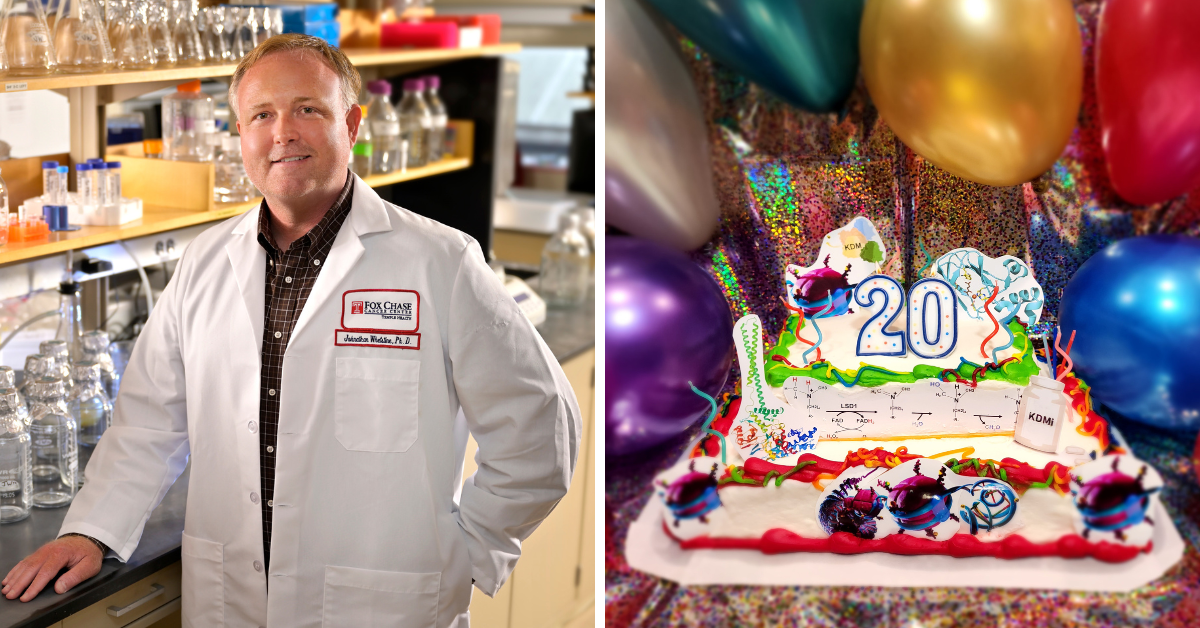
PHILADELPHIA (April 3, 2025) — Histone lysine demethylases, or KDMs, were first documented in 2004 in a groundbreaking study that led to new understandings about the genetic mechanisms of cancer and other diseases. Now, researchers at Fox Chase Cancer Center have marked the 20th anniversary of this landmark discovery with a new paper in the prestigious journal Cell that reviews two decades of research and advances.
The paper discusses key discoveries and developments, the current state of the field, and future directions for research and drug development. With approximately 400 citations, the review was intended to be a “one-stop shop” summarizing KDM research to date, said Johnathan Whetstine, PhD, Director of the Cancer Epigenetics Institute at Fox Chase and the study’s lead author.
“The goal is for this to be a comprehensive tool for people who know the field, but also to serve as a user guide for those who don’t,” added Whetstine, who is also the Jack Schultz Chair in Basic Science. He conducted the review with other Fox Chase scientists.
Histones are proteins that help strands of DNA wrap into small structures that can fit inside the nucleus of a cell. These proteins can be chemically modified in order to unspool the DNA and turn certain genes on or off. One such modification is a process called lysine methylation.
For years, scientists had debated whether methylation could be reversed. The 2004 discovery of the enzyme lysine specific demethylase 1, or LSD1, confirmed that demethylation was possible for the first time. Subsequent research showed that LSD1 and similar enzymes were overexpressed in leukemias and other cancers.
“This discovery has laid the groundwork for an entire field of epigenetics or chromatin biology,” said Whetstine, a postdoctoral student at the time of the study and a coauthor on the landmark paper. He went on to discover a large class of lysine demethylases called Jumonji-C enzymes.
He recalled that the initial discovery of LSD1 led to a “race” to find and investigate more.
“A whole slew of people ran into this space. There was a massive convergence that was kind of insane,” he recalled. “We had to cook fast and move quick. It was thrilling.”
In the decades since that time, considerable progress has been made toward understanding how KDMs work, their role in cellular function, how they may be involved in cancer and other diseases, and their potential as therapeutic targets. But Whetstine noted there is much work still to be done.
So far, only two KDMs have been targeted as potential cancer therapies, pointing to the need for more clinical trials, he noted. More research needs to be done in understanding how and when to target KDMs for different conditions, as well as investigating their potential as biomarkers. In addition, researchers need to take a closer look at what KDMs do beyond gene regulation and whether any of these functions present a therapeutic opportunity.
“I have a sneaking suspicion that there will be a new renaissance in this field,” Whetstine said.
“Hopefully our review not only paints the historical lines of KDM research, but also prompts the next generation of scientists to think about what they can do in this space. Because there’s a whole component to this that’s yet to be discovered.”
The paper, “20 Years of Histone Lysine Demethylases: From Discovery to the Clinic and Beyond,” was published in Cell.